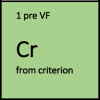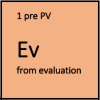The Periodic Table of Arguments considers an argument as a combination of one conclusion and one premise, both of which are expressed through statements that contain a subject and a predicate. Depending on the constellation of these subjects and predicates, an argument takes one of four possible argument forms. Arguments that share the same form are situated in the same quadrant of the table. [Read more about the theoretical framework and the basic terminology of the PTA.]
The Alpha Quadrant pictured above hosts all so-called ‘first-order predicate arguments’. The conclusion and premise of such arguments have the same subject (a) and different predicates (X and Y), so their argument form is:
a is X, because a is Y
An example is Since the suspect left a long trace of rubber on the road, we believe he was driving fast, which can be reconstructed as The suspect (a) was driving fast (X), because the suspect (a) left a long trace of rubber on the road (Y).
Within each quadrant, arguments are further differentiated based on their argument substance, the specific combination of types of statements. This is done by labelling the conclusion and the premise as a statement of fact (F), value (V), or policy (P). The example just mentioned has a statement of fact as its conclusion and another statement of fact as its premise, which means its argument substance is FF.
The working of arguments is based on the presence of a common term – the ‘fulcrum’ of the argument – and the existence of a relationship between the non-common terms – the argument lever. As pictured in Figure 1, first-order predicate arguments have the subject (a) as the fulcrum and the relationship between the predicates (Y and X) as the lever of the argument.

Figure 1. Conceptual representation of a first-order predicate argument
In the case of the above example, the lever is the relationship between left a long trace of rubber on the road and was driving fast. Since the former is taken to be an effect of the latter, this argument can be called an argument from effect.
Other examples of arguments within this quadrant are:

the argument from sign (Sig), which combines a statement of fact (F) with another statement of fact (F)

the argument from criterion (Cr), which combines a statement value (V) with a statement of fact (F)
 the pragmatic argument, which combines a statement of policy (P) with a statement of fact (F)
the pragmatic argument, which combines a statement of policy (P) with a statement of fact (F)

the argument from evaluation, which combines a statement of policy (P) with a statement of value (V)
